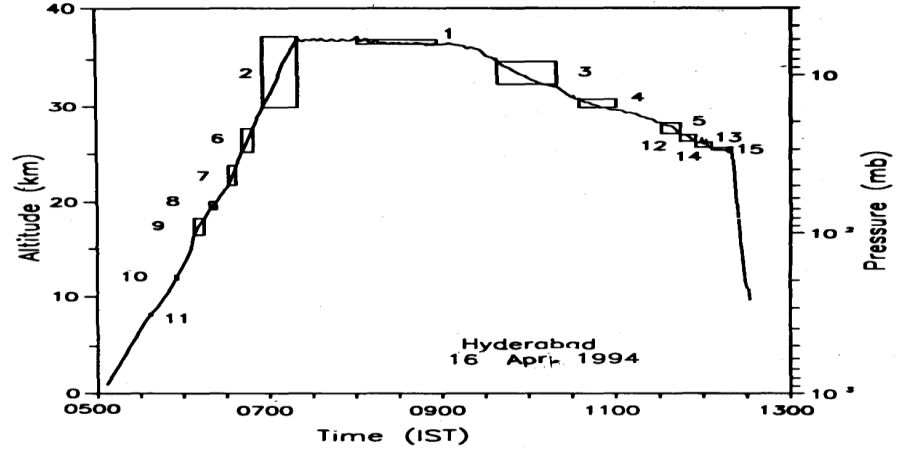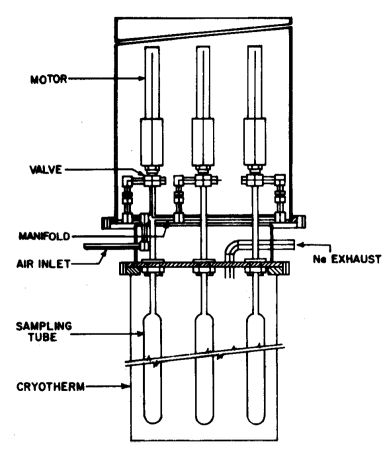Purpose of the flight and payload description
The objective of the flight was to obtain samples of ambient air at different altitudes in the troposphere and low stratosphere using a balloon-borne cryogenic air sampler. The instrument was developed by the Indian Space Research Organization (ISRO) as part of a program led by the Physical Research Laboratory (PRL), Ahmedabad to study the vertical distribution of various trace source gases over India.
In the image at left we can see an scheme of the cryosampler (click to enlarge). It consisted of sixteen electropolished, vacuum backed, stainless steel tubes with a volume of 400 ml each. Since the trace gases in the stratosphere are in very low concentration levels (parts per trillion by volume, pptv), the quality of tubes play an important role in the measurements. To remove impurities even at very small scale, each tube was baked several times at high temperature and high vacuum.
All the sampling tubes were assembled on a common manifold and each connected to bellow-sealed stainless steel Nupro valves which could be operated simultaneously at high vacuum and high pressure. The manifold was also connected to a ~2 meters air intake tube to avoid contamination of the samples due to degassing of the balloon gondola. Each valve was drived by a DC motor which ensured proper torque for leak tight closure. The manifold was kept on an interface which was attached to a dewar of 25 litres of capacity so that tubes were immersed in liquified neon (-246°C).
A constant pressure of 1.5 bar was maintained inside the dewar throughout the flight using a safety release valve. This motor valve assembly was enclosed in a thermally insulated, double walled chamber and was covered with an insulating transparent perspex plate on the top with O-rings to avoid the ambient cool air circulation. A hermetically sealed 50-pin connector was mounted on the plate which carried power for all the sixteen motors and thermistor connections. Cryosampler was completely enclosed in a specially designed light weight aluminium cage that allowed proper handling of the device during integration and also prevented any damage to the unit at landing. The sampler valves were operated by using a cryo-control unit that basically generated telecomannded signals to open or close the valve of the desired sampling tube.
Details of the balloon flight

Balloon launched on: 4/16/1994 at 5:06 IST
Launch site: TIFR National Balloon Facility, Hyderabad, India
Balloon launched by: National Balloon Facility, Tata Institute of Fundamental Research
Balloon manufacturer/size/composition: Zero Pressure Balloon Antrix - 146.369 m3
Flight identification number: 426
End of flight (L for landing time, W for last contact, otherwise termination time): 4/16/1994 at 13:00 IST
Balloon flight duration (F: time at float only, otherwise total flight time in d:days / h:hours or m:minutes - ): 8 h
Payload weight: 556 Kgs
Overall weight: 913 kgs
The balloon was launched from the TIFR balloon launch facility in Hyderabad on 16 April 1994 at 5:06 hrs IST. The sampling tubes were maintained at vacuum using a turbo molecular pump for more than a week and all the valves were closed just before the filling of liquid neon in the cryotherm prior to flight. The balloon take off was normal and intake tube was deployed by telecommand immediately after. Air samples were collected both during ascent and valve-controlled descent at desired altitudes by opening and closing the valves through telecommand. The air inside the manifold and intake tube was flushed with in situ air by opening a spare tube (#16) before collecting sample in each tube. Seven samples were collected during the ascent until the balloon reached a float altitude of 37 km which was maintained during one hour. After that, the balloon started a controlled slow descent during which eight air samples were collected. Once it reached an altitude of 25 km at 12:20 IST the flight was terminated. The cryosampler, telemetry, telecommand units and apex valve of the balloon were successfully recovered.
The collected samples were analysed at Physical Research Laboratory (PRL), Ahmedabad, using gas chromatographic techniques for many of the trace source gases.
External references
- A study of the atmospheric photochemical loss of N2O based on trace gas measurements Chemosphere - Global Change Science, Volume 2, Issues 3-4, 1 July 2000, Pag. 455
- Balloon Flight Report 1969 -2003 TIFR website (via Archive.Org)
- Balloon-borne cryogenic air sampler experiment for the study of atmospheric trace gases IJRSP Vol.25(1) [February 1996]
- Chlorine partitioning in the stratosphere based on in situ measurements Tellus (2000), 52B, Pag. 934
- Mechanical properties of ANTRIX balloon film and fabrication of single cap large volume balloons Advances in Space Research 42 (2008) 1691
2739If you consider this website interesting or useful, you can help me to keep it up and running with a small donation to cover the operational costs. Just the equivalent of the price of a cup of coffee helps a lot.


